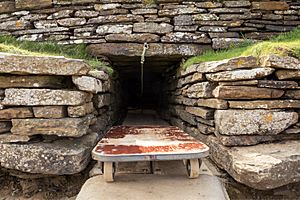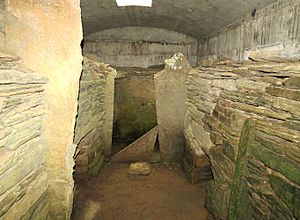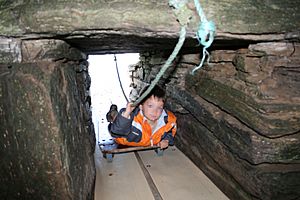Tomb of the Eagles facts for kids
The Tomb of the Eagles, or Isbister Chambered Cairn, is a Neolithic chambered tomb located on a cliff edge at Isbister on South Ronaldsay in Orkney, Scotland. The site was discovered by Ronald Simison, a farmer, when digging flagstones in 1958; he conducted a limited excavation and removed some bones and skulls at that time but filled in the site with dirt. A more extensive excavation was started in 1976, and "an enormous amount of material was removed", according to a report published in 2002.
Alerted by Simison, archaeologist John Hedges mounted a full study, prepared a technical report and wrote a popular book that cemented the tomb's name. The Archaeological Journal review of the Hedges book (Tomb of the eagles a window on Stone Age tribal Britain) provided a less than stellar rating: "reasonably well done", "but how very much better it might have been".
The findings
At the site, 16,000 human bones have been found, from at least 324 individuals, but no intact skeletons were discovered. Mixed with the human bones were talons and bones from eight to 20 birds. Some believed that the eagle was a totem animal for the individuals entombed here, but subsqeuent research indicated that the bird artifacts were added at a later time. These were identified as predominantly belonging to the white-tailed sea eagle (Haliaeetus albicilla). The original interpretation of the bird artifacts suggested a foundation deposit. That interpretation was subsequently challenged by new dating techniques. These reveal that the eagles died c. 2450–2050 BCE, up to 1,000 years after the building of the tomb. This confirms growing evidence from other sites that the neolithic tombs of Orkney remained in use for many generations.
According to a well documented research report, the builders of the tomb were capable of "sophisticated architectural design" and had "advanced engineering skills and an understanding of astronomy and mathematics"; the labourers had "exceptional talent, especially since it is assumed that only primitive tools were available". Radiocarbon dating suggests that the construction may have taken a full century. Archeologists believe that the tomb "was used regularly for 800 years, with the last burial around 1600 BC". Expert anaysis of the bones indicates that "these people experienced energetic lives of health, but also encountered many of the injuries and diseases that afflict contemporary society". A later expert examination of the 85 skulls, however, indicated that at least 20% had sustained some type of violent injury, possibly from "wooden clubs and stone axes".
Access the tomb is via a low tunnel 3 metres (9.8 ft) long. Visitors can lie flat on a wheeled trolley, and then stand up in the interior of the tomb.
See also
 In Spanish: Tumba de las Águilas para niños
In Spanish: Tumba de las Águilas para niños




